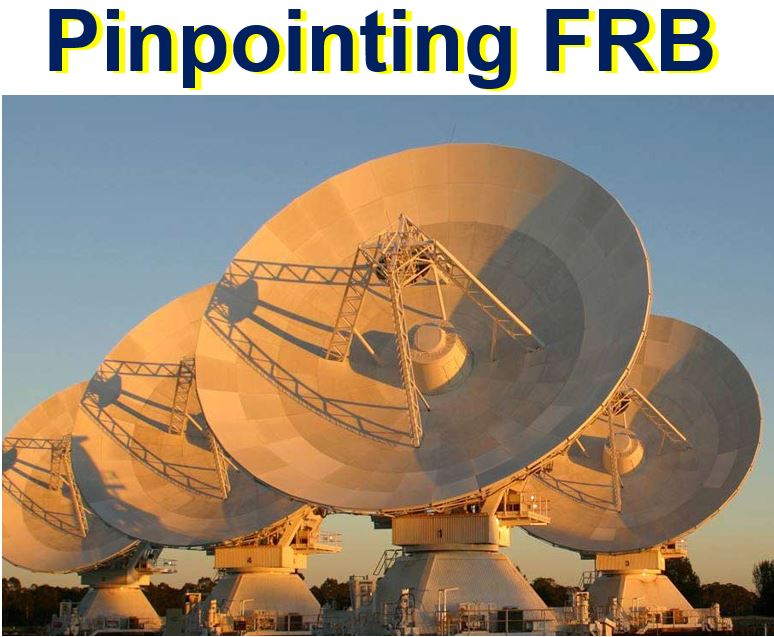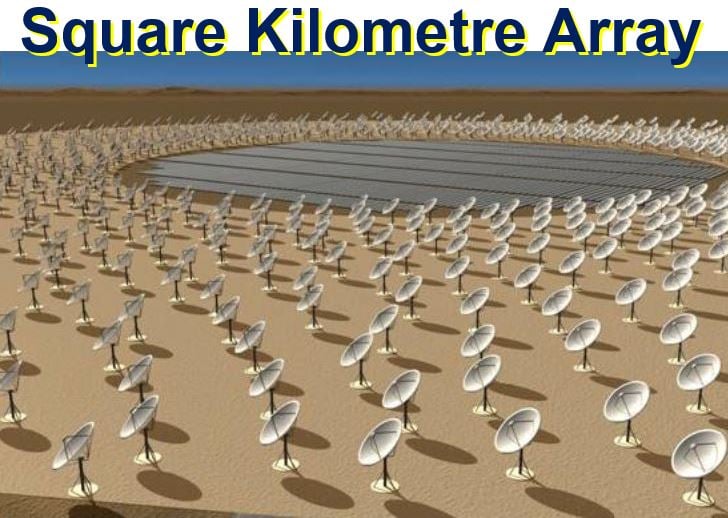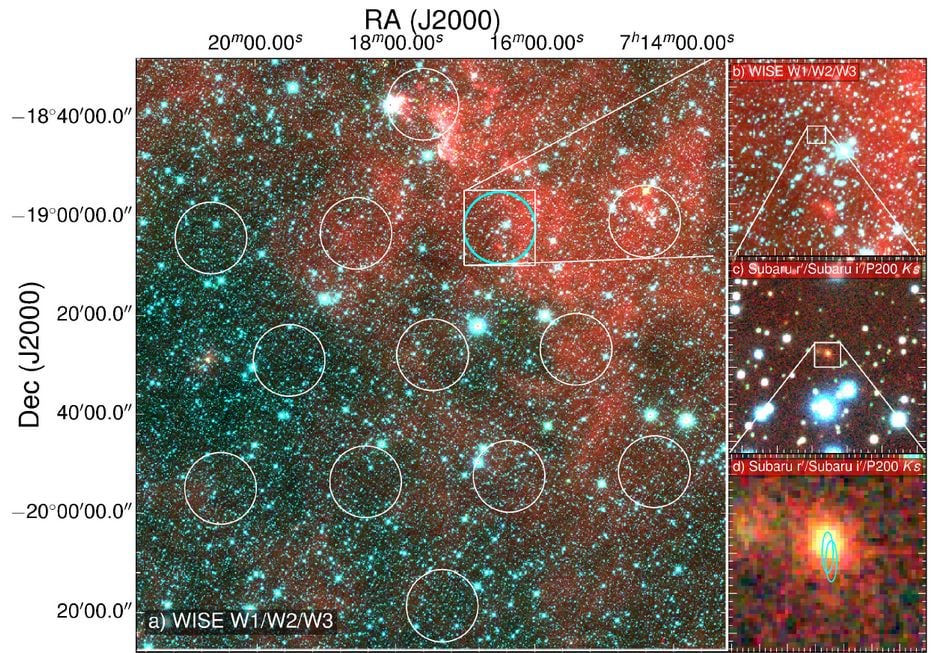We have been detecting strange radio bursts for several years, but never knew where they came from, that is until now. An international team of astronomers have pinpointed the last one detected – it comes from a fairly old galaxy about 6 billion light years from here, they say.
These FRBs (fast radio bursts) have been puzzling scientists for nearly ten years. Some very imaginative people have suggested that they came from super-advanced civilizations, while others believe they were cause by two very dense objects colliding, such as black holes or neutron stars, black hole explosions, or the hyperflares of magnetars (neutron stars with a very strong magnetic field).
The scientists who located this latest FRB wrote about their findings in the academic journal Nature (citation below).
 The Australia Telescope Compact Array, in New South Wales, helped identify the location of the latest fast radio burst. (Image: atnf.csiro.au)
The Australia Telescope Compact Array, in New South Wales, helped identify the location of the latest fast radio burst. (Image: atnf.csiro.au)
They say they identified its location by using a combination of optical and radio telescopes, which allowed them to confirm the current cosmological model and distribution of matter in the Universe.
The Square Kilometre Array (SKA), a huge radio telescope project which aims to have a total collecting area of approximately one square kilometre at two sites full of telescopes – one in South Africa and the other in Australia – has brought together top scientists, engineers and policy makers from over twenty countries, as well as more than one hundred companies.
The SKA Organisation is led by a team at Jodrell Bank Observatory, part of the University of Manchester in England.
FRB first detected in Australia
This latest FRB was detected by the 64-metre wide Parkes Radio Telescope (Parkes Observatory) in New South Wales, Australia. It automatically triggered a global alert to follow it up with telescopes. Within a few hours, scores of telescopes worldwide were looking for the signal.
An FRB is a very high-energy astrophysical phenomenon manifested as a transient radio pulse that lasts just a few milliseconds (thousandths of a second). So far, seventeen FRBs have been detected, sixteen of them by the Parkes Radio Telescope.
 An artist’s impression of an FRB reaching Earth. Lasting just a fraction of a second, yet packing a colossal amount of energy, FRBs are brief flashes that appear to come from random directions. Scientists believe the Universe is rocked by thousands of these events each day. (Image: cmu.edu)
An artist’s impression of an FRB reaching Earth. Lasting just a fraction of a second, yet packing a colossal amount of energy, FRBs are brief flashes that appear to come from random directions. Scientists believe the Universe is rocked by thousands of these events each day. (Image: cmu.edu)
Co-author, Dr. Evan Keane, lead scientist in this latest study, a Project Scientist at the Square Kilometre Array Organisation, said regarding previous FRBs that were detected:
“In the past, FRBs have been found by sifting through data months or even years later. By that time it is too late to do follow up observations.”
Immediate FRB detections
Detecting an FRB months or years after it happened was frustrating, because scientists could not study it any further. It is a bit like the police at a crime scene, the quicker they get there after the crime was committed, the more fresh evidence they can gather, which increases their chances of solving the crime.
To remedy this problem, the international team developed its own unique observing system to detect FRBs within a few seconds of receiving them, and to let other telescopes know about them immediately.
If other telescopes can know about it fast enough, there is still time to search for further evidence following the initial flash – there is usually an ‘afterglow’ after the flash.
Thanks to CSIRO’s Australian Telescope Compact Array’s six 22-metre dishes and their combined resolution, the astronomers were able to determine where the signal came from with far greater accuracy than had ever been possible before.
 An artist’s impression of the Square Kilometre Array (SKA). According to the University of Cambridge: “The SKA is a new radio telescope project, currently in the design study phase, which will have sensitivity 100 times greater than the most sensitive radio telescopes of the present generation, and an ability to survey the sky up to 1 million times faster. It is planned to be a “world array” and will be located partly in South Africa and partly in Australia.” (Image: phy.cam.ac.uk)
An artist’s impression of the Square Kilometre Array (SKA). According to the University of Cambridge: “The SKA is a new radio telescope project, currently in the design study phase, which will have sensitivity 100 times greater than the most sensitive radio telescopes of the present generation, and an ability to survey the sky up to 1 million times faster. It is planned to be a “world array” and will be located partly in South Africa and partly in Australia.” (Image: phy.cam.ac.uk)
They managed to detect a radio afterglow that lasted for six days before it faded away.
By analyzing the afterglow, the scientists could determine where the FRB came from one thousand times more accurately than before.
Benjamin Stappers, co-author, a Professor of Astrophysics at the University of Manchester, said regarding this latest FRB and future ones:
“The key to this project was the rapid localisation of the FRB and identifying the host galaxy. Discovering more FRBs will allow us to do even more detailed studies of the missing matter, and perhaps even study dark energy.”
“To do this, we are starting projects with arrays of telescopes like e-MERLIN and MeerKAT, which will allow us to have a localisation directly from the burst itself.”
 (Left) The field of view of the Parkes telescope. (Right) Successive zoom-ins on the area where the signal came from (cyan circular region). The image at the bottom right shows the Subaru Telescope’s image of the FRB galaxy, with the superimposed elliptical regions showing the location of the fading 6-day afterglow seen with ATCA. (Image:subarutelescope.org. Credit: D. Kaplan & E. F. Keane)
(Left) The field of view of the Parkes telescope. (Right) Successive zoom-ins on the area where the signal came from (cyan circular region). The image at the bottom right shows the Subaru Telescope’s image of the FRB galaxy, with the superimposed elliptical regions showing the location of the fading 6-day afterglow seen with ATCA. (Image:subarutelescope.org. Credit: D. Kaplan & E. F. Keane)
The NOAJ’s (National Astronomical Observatory of Japan’s) 8.2-metre wide Subaru optical telescope, located at Mauna Kea, Hawaii, was used to look at where the FRB came from – which was found to be an elliptical galaxy about six billion light years from Earth.
First time an FRB was pinpointed
According to Dr. Keane, it was the first time anyone had managed to identify an FRB’s host galaxy. The scientists were also able to determine the redshift measurement – the speed at which that distant galaxy was shifting away from us due to the accelerated expansion of the Universe.
Co-author, Dr Simon Johnston, Head of Astrophysics, CSIRO Astronomy & Space Science, said:
“Until now, the dispersion measure is all we had. By also having a distance we can now measure how dense the material is between the point of origin and Earth, and compare that with the current model of the distribution of matter in the Universe. Essentially this lets us weigh the Universe, or at least the normal matter it contains.”
Scientists believe our Universe consists of 70% dark energy, 25% dark matter, and 5% ordinary matter. Ordinary matter is what we can see.
Scientists found the ‘missing matter’
Even with ordinary matter, we have only been able to see about half of it – the part we’ve been unable to see is called ‘missing matter’.
Dr. Keane said regarding this missing matter:
“The good news is our observations and the model match, we have found the missing matter. It’s the first time a fast radio burst has been used to conduct a cosmological measurement.”
 Image shows the increased delay in the arrival time of the FRB as a function of the frequency. The delay in the signal is caused by the material it goes through between its point of origin and Earth. (Image: subarutelescope.org. Credit: E. F. Keane)
Image shows the increased delay in the arrival time of the FRB as a function of the frequency. The delay in the signal is caused by the material it goes through between its point of origin and Earth. (Image: subarutelescope.org. Credit: E. F. Keane)
The Square Kilometre Array – with its super sensitivity, resolution and wide field of view – will probably detect hundreds of FRBs and tell us where they all came from, the scientists said.
When we have data on many more FRBs, we will be able to make more precise measurements of cosmological parameters, such as the distribution of all matter in the Universe, which will give us a significantly better understanding of dark energy.
Astrophysicists say dark energy acts in opposition to gravity and accounts for most of the Universe’s energy – it also causes the Universe to expand at an accelerated rate.
FRB likely came from neutron star collision
This latest FRB’s host galaxy is relatively old, the researchers believe, and so has lost most of its star-making capacity. Because of that, Dr. Keane and team believe that the FRB came from two neutron stars that collided after orbiting each other.
The FRB’s brevity is consistent with the estimated timescale for such a collision, rather than two larger objects crashing into each other, such as white dwarfs (small very dense, planet-size stars), or a massive supernova (the result from the rapid collapse and violent explosion of a massive star).
Not all FRBs fit the scenario for a two neutron stars colliding, Mark Zastrow wrote in Nature News. In December 2015, astronomer Kiyoshi Masui of the University of British Columbia in Vancouver, Canada, and colleagues reported a detection by the Bank Telescope in West Virginia that they believe originated from a young neutron star with a strong magnetic field emitting intense flares.
This suggests that there are probably several types of FRBs – from different origins. Victoria Kaspi, an astronomer at McGill University in Montreal, Canada, said: “The implications for the origins of FRBs are still a bit unclear.”
Citation: “The host galaxy of a fast radio burst,” S. Yamasaki, T. Terai & N. Tominaga, M. Berezina, M. Mickaliger, C. Bassa, E. F. Keane, S. Johnston, S. Bhandari, E. Barr, N. D. R. Bhat, M. Burgay, M. Caleb, C. Flynn, T. Morokuma, Y. Niino, H. Sugai, A. Jameson, R. Wayth, P. Chandra, D. Perrodin, M. Kramer, E. Petroff, A. Possenti, T. Hattori, N. Yasuda, R. Allen, D. L. Kaplan, S. J. Tingay, A. Williams, W. van Straten, M. Bailes, S. Burke-Spolaor, T. Totani, M. Honma, H. Furusawa, R. P. Eatough, B. W. Stappers, J. Cooke, J. Jencson and M. M. Kasliwal. Nature. 25th February 2016. DOI:10.1038/nature17140.
Video – Enigmatic Radio Burst Tracked to Distant Galaxy

